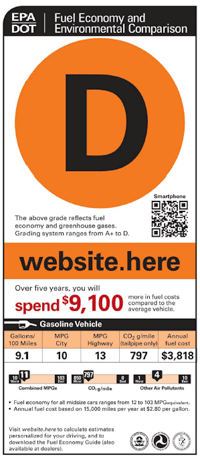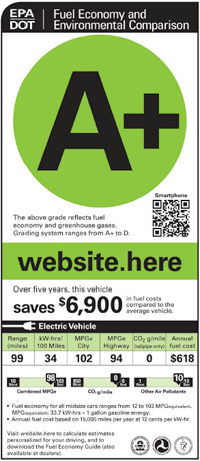The Environmental Protection Agency and Department of Transportation this week released plans to update the label on the windshield of your next new car. The new tags would replace existing labels found throughout new car lots, which prominently display estimated city and highway miles-per-gallon averages.
The updated look, which offers considerably more information, is a bet on the part of government that more people will buy fuel-efficient cars if the accompanying sticker simply does a better, in-your-face job of explaining just how valuable they are — to the environment and your pocketbook.
After all, who wants to buy the pickup truck with the fluorescent-orange D on the windshield and the warning, “Over five years, you will spend $9,100 in fuel costs compared to the average vehicle”? The only thing officials have left off is the exclamation point.

The new designs, on which the agencies are now seeking public input, cover a smorgasbord of behavioral nudges. The car’s fuel efficiency gets a letter grade, A+ through D. There is a fuel consumption value (gallons used to travel 100 miles), a more direct indicator than MPG of actual fuel used. Another number tells how many grams of carbon dioxide are emitted by the car, per mile. Bar graphs show how these rates compare to other cars on the market.
And then there is the big dollars-and-cents figure, in some designs the most prominentnumber on the label. The current sticker estimates for consumers their annual fuel cost. The new one, by contrast, tells you what you’ll save — or spend — on gas relative to the driver of an average car.
The difference is subtle, but it taps into what social scientists now understand about our buying behavior when it comes to environmentally friendly products. Consumers are much more sensitive to the cost of a product now than theoretical savings it will lead to in the future. That means if you have to pay a premium today for an energy-efficient washer or hybrid to save more on fuel or electric bills over the life of the product, it’s a big help to tell people up front exactly what those savings will amount to.
Many people are more interested in cost savings than environmental benefits anyway.

“Different messages resonate with different people,” said Caroline Noblet, an economics research associate at the University of Maine. “Some people may respond to a message about specifically global warming solutions, and other people may respond more to something that talks about a different type of vehicle emission.”
This helps explain why the EPA and DOT are trying to push so many data points simultaneously. Noblet and colleague Mario Teisl also say they suspect the agencies have done their homework: Officials asked more than a year ago to review their ongoing research on environmental labels and car-buyer behavior in the state of Maine.
Teisl compares the newly intricate auto information to the evolution of nutrition labels. Those disclosures started off simple, too.
“But then over time, as people became more aware of it, more used to using it, then there were calls for adding more data,” he said. “‘Oh, we want transfat information on there. Oh, we want to know not just about fats, but whether it’s saturated, or unsaturated.’”

Miller-McCune’s Washington correspondent Emily Badger follows the ideas informing, explaining and influencing government, from the local think tank circuit to academic research that shapes D.C. policy from afar.
Something similar has happened with drivers, who’ve grown more sophisticated in their understanding of fuel efficiency and tailpipe emissions. To help them, the government also plans to include on the label a website where consumers can personalize the estimates to their own driving behavior. The labels will even contain a code that smart-phone users can scan to access the web page while standing right in the car lot.
These labels, designed in part to accommodate a market with plug-in hybrid and electric cars, will likely be more effective than the existing ones. But how will they compare as a behavioral prod to more overt – and punitive – tactics like gas-guzzler taxes that increase the cost of driving inefficient vehicles?
“To me, it’s a mixed bag,” Teisl said of the new labels. “Because as an economist – [we know] price is the most important attribute for consumers – you can manipulate prices to make people do what you want them to do.”
In other words, raising the price of fuel-inefficient vehicles would be the best way to get people to buy fuel-efficient ones.
“But given that the likelihood of getting a tax increase on carbon emissions is very unlikely, the next best thing is to in a sense circumvent the Congress or political lobbying and go directly to the consumer,” Teisl said. “My gut feeling is that it is politically more palatable for regulators and Congress to say, ‘Oh, we’re just giving more information, that’s a good thing. We’ll do that.’”





